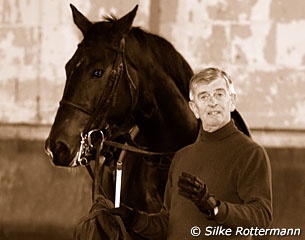
In the autumn of 2010 Eurodressage’s chief editor Astrid Appels asked the readers of Eurodressage to send suggestions for a topic they would like to read an article on. Colonel Christian Carde was one of the proposals
and as Eurodressage reporter Silke Rottermann was going to spend a week in Paris at the beginning of November she was kindly asked to meet one of France’s greatest horsemen of the past decades.
This is the second instalment of Rottermann's interview with Colonel Christian Carde. Read Part I here
A Representative of the “French School”
Today it seems in fashion to talk about “Légèreté” (Lightness) as the only French style of dressage riding which constrasts with the style seen in competitive dressage. An increasing number of riders interested in the art of classical dressage correlate it to “better” dressage riding because the aim is a very collected horse moving with self-carriage to the finest of aids. Colonel Christian Carde is a representative of the French School, though he would disagree there is only "one" French school.
Instead he states that “the French equestrian tradition was defined about 50 years ago by General Decarpentry, but he also regretted the absence of uniformity in the French style.” One cannot completely understand the Colonel’s vision of dressage without digging a bit deeper in the history of French Equitation, defining what légèreté really is about. Nowadays there seems to be a tendency to use the term almost randomy for any kind of dressage different to the one seen in the show ring.
For Carde the roots of the French dressage style go back to to Francois Robichon de la Guerinière and the legendary School of Versailles of the 18th century which closed after the Revolution. The influence of the former proved to be tremendous, not only in France, but to the whole system of dressage riding, especially for the Spanish Riding School in Vienna which still follows his principles. La Guérinière, who rode during the first half of the 18th century, defined légèreté as “the willingness of the horse to obey the rider voluntarily.” If a horse owns this willingness it enables the rider to direct the horse with loose or even dropped reins while continuing to do the exercises. The French call this “descente de main”. But to get a horse to a voluntary obedience one has to work on the suppleness and throughness of the horse.
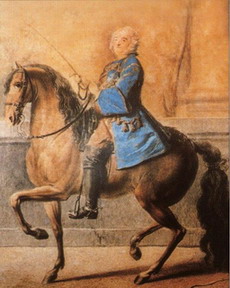 La Guerinière, director of the French royal stables, invented an exercise to make the horse more supple in its shoulders: the shoulder-in. He found out that this kind of exercise helps enormously to make all movements of the horse more flowing and comfortable. Until today this exercise plays an important role in the schooling of a dressage horse and all lateral flexions and also counter-flexions are still of importance in the French dressage school to make a horse flexible and mobile.
La Guerinière, director of the French royal stables, invented an exercise to make the horse more supple in its shoulders: the shoulder-in. He found out that this kind of exercise helps enormously to make all movements of the horse more flowing and comfortable. Until today this exercise plays an important role in the schooling of a dressage horse and all lateral flexions and also counter-flexions are still of importance in the French dressage school to make a horse flexible and mobile.
“There was La Guérinière of course, but also the French military school founded in Paris with its écuyer en chef, Dauvergne, in the middle of the 18th century which influenced the French riding style. The French revolution at the end of that century created a break and Saumur was founded at the beginning of the 19th century, referring to the School of Versailles, Dauvergne and modern military imperatives. And then Baucher came," Carde recited.
The name Baucher seems in fashion again. The late Jean-Claude Racinet and more recently the Austrian vet Dr. Stodulka have written several books about the methods of that controversial man, who started his career as a rider in the circus. Even today there are many discussions if Baucher was a genius or whether his methods should be questioned. Many negative voices reduce Baucher merely to jaw flexions and his claim that horses trained by his method are not forward.
In fact one has to differentiate between Baucher’s first and second method. Baucher, who must have been an exceptional rider teaching his circus horses several artificial movements such as trot and canter backwards, initially concentrated much on mobilising the lower jaw and the neck of the horse through several flexions. He intended to make the horse light in the hand, but at the same time many horses lost their will to go forwards. After an accident Baucher lost strength in his legs and recognised the weak spot in his system, altering his methodology into his "second method." He practised the flexions only at the beginning of a young horse’s training to avoid a loose neck.
During his lifetime Baucher’s method was not allowed in the cavalry but as he showed it in the army Saumur experimented with it and his system ended up having had an influence on French military riding. Many also forget that he invented the one-tempi changes which are part of every Grand Prix program to this day. Baucher stamped modern dressage in that way.
The Legacy of the Great French Masters: L'Hotte and Decarpentry
Carde confirms the legacy of Baucher: “Baucher really influenced the doctrine and his influence is still strong on trainers such as Jean-Claude Racinet, Dominique Ollivier or Franchet d’Esperey. Then General l’Hotte and General Decarpentry came and did a kind of cleaning up with their two books “Questions Equestres” (L’Hotte) and “Equitation Académique” (Decarpentry). They founded what is, in my opinion, the modern French equestrian tradition, which is a clever combination of sport and art.”
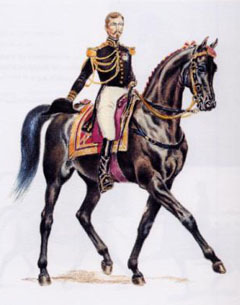 General Alexis l’Hotte, born 1804, had been an exceptional rider and instructor, who was écuyer-en-chef in Saumur from 1864 to 1870. He was Baucher's favourite student as well as d’Aure's, two trainers who had been such rivals. L’Hotte was able to find the common ground in both methods and combined them for the benefit of dressage. For him the word légèreté meant “an immediate obedience to the slightest rein or leg aids” and this is also the definition Christian Carde reads in “lightness”.
General Alexis l’Hotte, born 1804, had been an exceptional rider and instructor, who was écuyer-en-chef in Saumur from 1864 to 1870. He was Baucher's favourite student as well as d’Aure's, two trainers who had been such rivals. L’Hotte was able to find the common ground in both methods and combined them for the benefit of dressage. For him the word légèreté meant “an immediate obedience to the slightest rein or leg aids” and this is also the definition Christian Carde reads in “lightness”.
L’Hotte did not reduce the meaning of “lightness” to the contact with the bit only, but enlarged it by introducing the term “impulsion”. The horse has to react to the rider’s legs immediately and willingly, otherwise it is behind the bit and not “light” at all.
Though all those famous riding masters were exceptional in their own kind, General Decarpentry was the first who recognised the growing importance of riding as a sport and who was able to combine it with the art of riding. Decarpentry was born in 1878 and Carde refers to him the most. The general's father and grandfather were trained by Baucher and joined Saumur in 1904.
A serious injury to his left elbow in the infamous battle of Verdun during World War I did not hinder him to continue riding. In 1921 he was one of three founding fathers, alongside Dr. Gustav Rau and General von Holzing Berstelt from Germany, that established the Fédération Internationale Equestre (FEI) at the Olympic congress in Lausanne on 28 May.
As international dressage judge from 1930 to 1939 Decarpentry was responsible for writing the FEI regulations and he judged the Olympic dressage competitions in Berlin 1936, the first time in which piaffe and passage were required movements in the Olympic dressage program. His books “Piaffe and Passage” as well as “Academic Equitation” gave direction for the French dressage style represented by members of the Cadre Noir after World War II. Carde adds: “Decarpentry was a man of the sport and of the art and I tried to be this as well.”
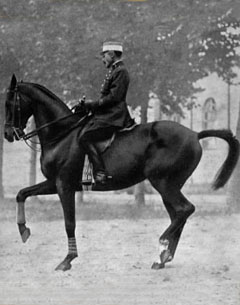 Though Carde most notably refers to L’Hotte and Decarpentry there have been two other, more recent riding masters, that strongly influenced his approach to dressage: Nuno Oliveira from Portugal and Willi Schultheis from Germany.
Though Carde most notably refers to L’Hotte and Decarpentry there have been two other, more recent riding masters, that strongly influenced his approach to dressage: Nuno Oliveira from Portugal and Willi Schultheis from Germany.
“Of course the main influence on my riding came from Saumur," said Carde "but I also met Nuno Oliveira regularly for more than 20 years until his untimely death and learnt much from him. The other influence came from a German, you may remember Willi Schultheis!”
Carde speaks with the greatest respect for the German trainer who probably had been Otto Lörke’s best student and who had a great influence on the German dressage scene for almost 40 years having trained the best riders and horses and as German national coach in the 1970s. Schultheis, who intended to become a jockey first, had a talent to train and present highly sensitive horses, also thoroughbreds like the Vornholz horses Chronist xx or Pernod xx.
“Schultheis rode with lightness. Even when he was an older man he was able to present the horses on a silk thread. Remember that unique performance he gave with Cindy Ishoy’s horse Dynasty at Essen in the 1980s!”
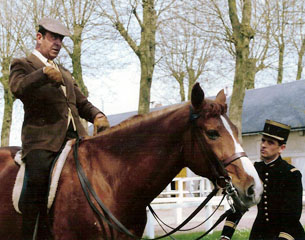 Carde recalls his time at Warendorf where he prepared his blood influenced horse Solitaire with Schultheis for the 1979 European Championships in Denmark. “All the German team horses had been stabled there and were worked by Schultheis daily. Their riders mainly had other duties to fulfil so I got the chance to ride some of those fabulous German horses. Just imagine that, only two weeks before a championship. Unthinkable today, isn’t it?”
Carde recalls his time at Warendorf where he prepared his blood influenced horse Solitaire with Schultheis for the 1979 European Championships in Denmark. “All the German team horses had been stabled there and were worked by Schultheis daily. Their riders mainly had other duties to fulfil so I got the chance to ride some of those fabulous German horses. Just imagine that, only two weeks before a championship. Unthinkable today, isn’t it?”
Carde is a representative of the French riding style and has always impressed with his exceptional correct seat and soft impact on his horses, still existent with him being 71 now. The Colonel’s best quality is another: While he unambiguously prefers the French principles he was prepared to learn from others as long as they aimed for lightness in their riding! “I could learn from many, also from students I trained, I learnt as a judge and from several talented riders I met at dressage events, particularly the late George Theodorescu.”
To have focus and a goal, but remaining open-minded, seems to be a rare, but invaluable human attribute.
Riding as Humanism
In modern times the horse had found its place as a partner of millions of leisure riders and in sport. Its function within the cavalry and agriculture disappeared. In former, less entertainment-orientated times horse riding was -- more often than nowadays -- an inner attitude: teaching patience, discipline and humility. In this way riding was an education of the human character. It still can be like that, but more and more one can observe the opposite, as money plays an important role for competitive riding even at lower levels today.
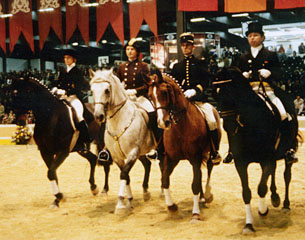 May it be ambitious parents of young talents or sponsors of international riders, the expectations have to be fulfilled. Christian Carde is the first to admit that the money needed today to be competitive has influenced the sport of dressage tremendously; not always in a positive way.
May it be ambitious parents of young talents or sponsors of international riders, the expectations have to be fulfilled. Christian Carde is the first to admit that the money needed today to be competitive has influenced the sport of dressage tremendously; not always in a positive way.
“The most important thing which is lacking in dressage today is humanism," Carde stated. "Riding became a “technique” much more than an art. The horse has to obey more than understand. All too often it is just the slave for reaching personal glory and success."
For Carde working with horses and riders is first and foremost establishing a “human partnership." It is the premise to allow the horse to understand and be eager to please and make it right for its rider. According to Carde we find the beginning of enslaving horses when pure technical demands take priority. This is only possible because of the generosity horses show towards humans.
Putting Words into Action
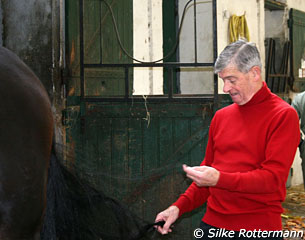 Carde puts his own words into action by offering Eurodressage's Silke Rottermann to attend a training session in Saumur, where he explained and demonstrated his vision of dressage and horsemanship.
Carde puts his own words into action by offering Eurodressage's Silke Rottermann to attend a training session in Saumur, where he explained and demonstrated his vision of dressage and horsemanship.
To be honest I had mixed feelings on my way to Saumur where I was to meet the Colonel at the “Ecole de Cavalerie”, the place where his horse are stabled. Would I meet a great equestrian personality who is rather a technocrat or a true horseman practising what he preaches? When I joined him in the old stable buildings at the edge of the school my question was immediately answered. It doesn’t require an expert to see at first glance that there is a relationship of extraordinary quality between the Colonel and the dark bay horse tied up next to the tack room.
“This is my horse, Junker. He is a 13-year old Westfalian gelding by Pluspunkt. So he has rather a jumping pedigree," Carde said upong introducing me to his horse with friendly, bright looking eyes. He prepared him all by himself, no groom in sight: “I just came back from the USA and I hope you do not expect something spectacular. I am going to show you my approach to classical dressage with Junker.”
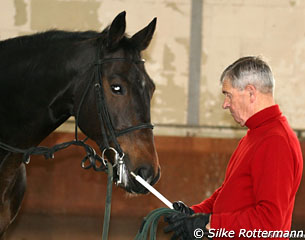 On the way to the old indoor arena of the military school Carde said that “riding means establishing a partnership with the horse. This is very important and cannot be done by just sitting in the saddle. I am riding in the tradition of lightness, the classical French riding style in which the horse reacts to the slightest of aids. I always start with an extensive warm-up phase either by working in-hand or lunging the horse. Today I am going to demonstrate you both.”
On the way to the old indoor arena of the military school Carde said that “riding means establishing a partnership with the horse. This is very important and cannot be done by just sitting in the saddle. I am riding in the tradition of lightness, the classical French riding style in which the horse reacts to the slightest of aids. I always start with an extensive warm-up phase either by working in-hand or lunging the horse. Today I am going to demonstrate you both.”
Carde’s horse wore a double bridle with a loose noseband and a French curb (swivel weymouth). The gelding waits patiently and with interest next to his rider while Carde attaches a long lunge line in a way unknown to me so far. The clip of the lunge was attached to the outer snaffle ring going through a carbine attached to the front of the saddle and back through the inner bit ring to the hands of the rider. Carde explained that this kind of buckling a lunge needs an experienced trainer and a very well trained horse full of faith in the rider’s hands.
“The way I have attached the lunge line to Junker is exactly the way General Decarpentry described in his famous book “Academic Equitation”. It is only useful if a horse yields and isn’t pulling. Otherwise it could produce very harmful effects. With a young horse I would use a cavesson.”
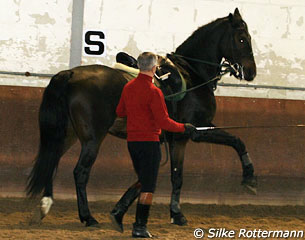 Carde added that one typical dressage problem is that many riders only concentrate on the hind legs of the horse. Equally important is to pay enough attention to the forehand. The activity of the hind legs has to go hand-in-hand with the lifting of the shoulders and the rising of the withers.
Carde added that one typical dressage problem is that many riders only concentrate on the hind legs of the horse. Equally important is to pay enough attention to the forehand. The activity of the hind legs has to go hand-in-hand with the lifting of the shoulders and the rising of the withers.
The Colonel began by working on Junker's shoulders first walking next to him and encouraging the gelding to lift them by turns. It looked a little like Spanish walk, but Carde denied that it is the same: “This exercise is only for lifting the shoulders and rising the withers and should not be mixed up with the classical Spanish walk.” After mobilising the shoulders Junker was asked to engage his hind legs by showing half steps similar to piaffe.
The 13-year old Westfalian is no horse with breathtaking paces, nor is he extraordinarily impressive in its appearance, but the deep bond between Carde and his horse was much more fascinating to see than any spectacular action. It was a kind of mutual understanding I had rarely witnessed in my life.
Carde finished his handwork and started demonstrating his lunging work. For this he changed the buckling of the lunge a bit by attaching the carbine to the saddle girth, leading through the outer snaffle bit ring and again going through the carbine attached to the front of the saddle and back through the inner bit ring to Carde’s hand.
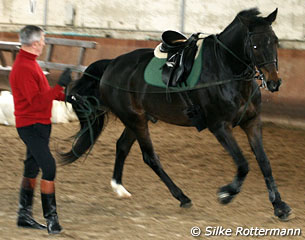 He then started with something the French call “petit trot”, a kind of accentuated trot which looks a bit like the beginning of passage and in which the horse makes small steps. The horse had to move with collection and elevation. After some rounds Junker was sent in a more forward going trot before being asked again for the "petit trot" and so on. By having to make transitions like that Junker engaged his hind legs and opened his frame when being sent forward. It worked the same way in the canter. Carde asked his horse for a strike off in collected canter on the circle and minimised the circle line until the horse cantered around him on a small volte. It was hard work and Junker broke into trot one time, but he very willingly reactzs to the Colonel’s “Allez go!” and started cantering again. He released the horse by enlarging the volte to 20m circle length and sent Junker forward to lengthen his strides. This was one of the main principles of Carde’s training: A phase of collected work, no matter if at the lunge or under the saddle, followed by a phase in which the horse is allowed to stretch. While lunging Carde did not only give signals with the lunge line and whip, but also with his body and voice to encourage the horse to work in the intended way.
He then started with something the French call “petit trot”, a kind of accentuated trot which looks a bit like the beginning of passage and in which the horse makes small steps. The horse had to move with collection and elevation. After some rounds Junker was sent in a more forward going trot before being asked again for the "petit trot" and so on. By having to make transitions like that Junker engaged his hind legs and opened his frame when being sent forward. It worked the same way in the canter. Carde asked his horse for a strike off in collected canter on the circle and minimised the circle line until the horse cantered around him on a small volte. It was hard work and Junker broke into trot one time, but he very willingly reactzs to the Colonel’s “Allez go!” and started cantering again. He released the horse by enlarging the volte to 20m circle length and sent Junker forward to lengthen his strides. This was one of the main principles of Carde’s training: A phase of collected work, no matter if at the lunge or under the saddle, followed by a phase in which the horse is allowed to stretch. While lunging Carde did not only give signals with the lunge line and whip, but also with his body and voice to encourage the horse to work in the intended way.
It was really impressive how much Junker listened to him almost all the time and tried his hardest while never being tense or frightened. He not only showed complete faith in his rider, but also a seldom-seen eagerness to please him, very different from a horse simply obeying. This probably was what Guerinière meant with the "voluntarily obeying horse".
"A tense or frightened horse will not be able to learn, it can just obey"
My impression was confirmed when Carde displayed an innocent little trick with his horse. The lunge line hung loose and Junker had his ears pricked, eagerly awaiting an obviously well-known game with his master. “En arrière! En arrière," Carde commanded. Junker walked backwards just by himself, fluently and straight. His alert eyes didn't lose sight of his rider for a second. “Come here” and Junker approached him again looking as happy as a horse can be. He was praised by Carde who stroked Junker’s head affectionately.
”It is important to start slowly like this before mounting a horse. And it is also of great importance to allow the horse to take a breather, to relax and pause before demanding something again. Only a relaxed horse can learn and understand what we want it to do. A tense or frightened horse will not be able to learn, it can just obey,” Carde stressed before he mounted Junker.
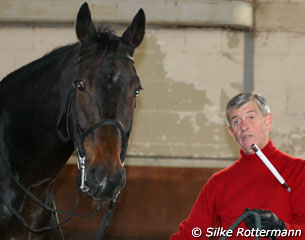 The Westfalian chewed on his bit contently, producing the kind of foam which is desired, looking like the topping of a good cappuccino. “Yes, he is relaxed in his mouth. Unfortunately we all too often see horses producing either almost no foam or exaggerated foam. Both are an indicator that the mouth is not relaxed whatever the reason."
The Westfalian chewed on his bit contently, producing the kind of foam which is desired, looking like the topping of a good cappuccino. “Yes, he is relaxed in his mouth. Unfortunately we all too often see horses producing either almost no foam or exaggerated foam. Both are an indicator that the mouth is not relaxed whatever the reason."
Carde continued: "If we train a horse we are never allowed to forget the physical constitution and limits every horse has. If we respect these limits in our work the horse stays healthy and will be willing to work. One thing I am aiming at now while riding is the roundness of the topline of the horse with the head coming close to the vertical. There are two ways of getting there: One way is to pull the mouth of the horse backwards. The result is a horse with a tight neck, stiff back, and stiff in its gaits not able to show a proper walk. The other way is to lengthen the topline above the bit and get it supple. I am now going to show you to get the horse on the bit first and then continue to collect the horse, which is my second aim, so it moves with lifted shoulders and engaged hind legs in a round frame”.
Carde demonstrated how he did it in the walk and marked the necessity to ride the horse on the bit only with the snaffle rein. “The curb rein is only there either to relax the horse in the mouth or to prevent the horse coming above the bit," he commented. With sagging curb reins Carde flexed Junker laterally by pushing the croup out and bringing the inner shoulder in and thereby also riding the horse on the bit.
Junker did it beautifully. The Colonel added: “As soon as you have the hold of the bit, stretch the horse. The more you collect the horse the more you must stretch it afterwards, it is very important. You get the bit contact by doing normal lateral flexions and by doing lateral counter- flexions. These are also useful suppleness exercises.”
True to the word Junker showed a very nice elevation with his poll really the highest point and he looked very light in the hand. Carde elaborated on it: “You can only succeed in collecting the horse if you keep the activity while slowing down” and he demonstratesd it by keeping the contact with the mouth and the hind legs active on a circle in trot. Junker got visually shorter and was allowed to stretch soon after again.
Carde then asked for the utmost collection and Junker started to piaffe. The Westfalian does not have high forehand action, but he showed amazing lightness and relaxation in his execution on the spot. With a very fine rein contact he remained elevated and in front of the vertical: No hiding behind the vertical, no nose at breast height, no tension, no swooshing tail.
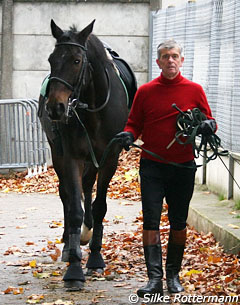 Carde displayed something very different and less spectacular with a completely relaxed horse. Everybody can determine for himself what he prefers. For me there's no question.
Carde displayed something very different and less spectacular with a completely relaxed horse. Everybody can determine for himself what he prefers. For me there's no question.
The pair demonstrated how elevated and uphill a really supple horse will remain only by riding with the weight of the reins (descente de main). Junker did it in trot as well as canter and worked engaged from behind. This is what representatives of the “French School” call the ultimate lightness, a horse which is that collected that it stays uphill even with dropped reins.
Old Xenophon’s words come to my mind: “Get the horse used to carry the poll elevated and the topline round and it will be happy and like it.é
Carde seemed to be content with Junker and finished the session by given him the reins in walk. Horse and rider had worked hard the past 45 minutes on a rather warm November day, but there wasn't a drop of sweat to be detected on any of them.
I took a nice symbolical picture when Carde and Junker walked side by side back to the stables. Christian told me he would be back after lunch to groom him. The horse’s eyes were shining. This smart gelding seemed to be aware that he is in the hands of an exceptional rider, who-- I have learnt now-- is no technocrat, but a humanist first-class.
Article by Silke Rottermann for Eurodressage.com
Continue: Colonel Christian Carde, Classical Dressage as Horsemanship - Part III
Related Link
Colonel Christian Carde, Classical Dressage as Horsemanship - Part I